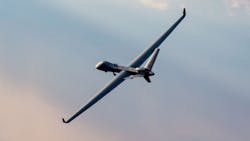Air Force SOC Orders MQ-9B SkyGuardians
Backed by more than 20 years working as a partner with General Atomics Aeronautical Systems, the U.S. Air Force Special Operations Command (AFSOC) has entered into a new contract with the company for three MQ-9B SkyGuardian remotely piloted vehicles (RPVs). The transaction was made during a time when an MQ-9A Reaper unmanned aerial system (UAS) was destroyed by Russian fighter aircraft while performing long-endurance missions in international airspace.
General Atomics has built a strong reputation for the reliability of its drones by having supplied more than 40 MQ-9A Reapers around the world. The MQ-9B version of the Reaper will feature the development of the AFSOC’s Adaptive Airborne Enterprise (A2E) concept for beyond-the-horizon scanning and monitoring of airspace. It uses a combination of large UAS vehicles and smaller, expendable unmanned aerial vehicles (UAVs).
David R. Alexander, president of General Atomics Aeronautical Systems (GA-ASI), said, “We’re very excited to continue our great partnership with AFSOC well into the future.” Concerning the capabilities of the aircraft in dealing with changing global environments, he added, “MQ-9B is the ideal platform for inserting air-launched effects into potentially hostile environments. The MQ-9B’s combination of range, endurance, reduced manpower footprint, and overall flexibility will make it a true centerpiece of AFSOC’s future family of advanced UAS systems.”
The MQ-9B SkyGuardian (see image above) has been tested for more than 40 hours for airborne endurance and the capability to perform automatic takeoffs and landings via solely satellite-communications (satcom) control signals. The “B” version of the RPV incorporates a number of upgrades and subsystem additions to the “A” version, including a GA-ASI-developed Detect and Avoid System.
About the Author
Jack Browne
Technical Contributor
Jack Browne, Technical Contributor, has worked in technical publishing for over 30 years. He managed the content and production of three technical journals while at the American Institute of Physics, including Medical Physics and the Journal of Vacuum Science & Technology. He has been a Publisher and Editor for Penton Media, started the firm’s Wireless Symposium & Exhibition trade show in 1993, and currently serves as Technical Contributor for that company's Microwaves & RF magazine. Browne, who holds a BS in Mathematics from City College of New York and BA degrees in English and Philosophy from Fordham University, is a member of the IEEE.
